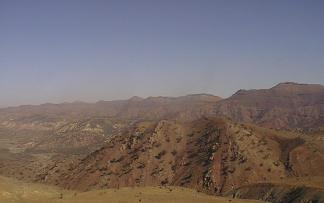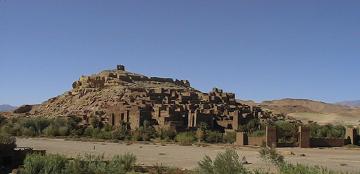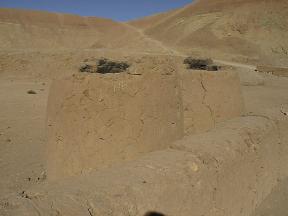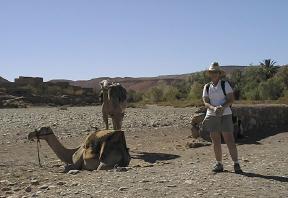
Ouarzazate
August 18st - August 20th, 1999

Having had our fill of Marrakesh "culture", we decided to check out a town smaller than any we've visited and readily accessible by bus. Ouarzazate (yow-zah-zaht) lies nestled in a valley in the High Atlas mountains, the range that separates the populated sections of Morocco from the Sahara desert. Our bus ride ran for much of the trip alongside a small riverbed that, to our amazement and despite the searing late summer heat, would frequently contain water. Even though we saw no mountain with snow on top, the water the snowmelt generates never quite gives out along this little valley. Small agricultural communities utilize the river and irrigation and maintain all sort of fields of grains, vegetables and fruit unbelievable given the searing heat and the dry, scrabble landscape. Most buildings are mud and hay constructions, nestled low and frequently built into the side of the mountains (photo below).

The High Atlas mountains are formed by some sort of thrust fault, and are made up of the sediments of an ancient ocean bed. We don't have our references handy, but from judging from the numerous fossils for sale along the side of the road, much of the contents of the rock dates from over 600 million years ago (trilobites, very large snail and nautilus). The mountains are also a geologist's dream, full of minerals, crystal and geodes.
One thing the tour books didn't talk about is that the locals call Ouarzazate the "Hollywood of Morocco" as it has the country's only film production studio. Visible from the highway (below), most major film companies use Morocco as a convenient place to film desert shots. Many locals find jobs for the big productions that come through town, or in the five star hotels that cater to stars and crews. The show biz is hopping this season, judging from the number of film sets under construction and crews in the supermarket stocking up on water, beer (you can buy alcohol here!) and toilet paper.

By the way, the name "Ouarzazate" is biblical in origin and means "there where there is no sound." Sure wish Ouarzazate of today were as quiet as when it was named.
Kasbah of Taourirt
Back when the French were in control, one family pulled the strings in Ouarzazate: the Glaoui. Granted control of the entire south of Morocco in 1912, El Glaoui, the Pasha of Marrakesh and a friend of Winston Churchill, kept his pleasure palace in Ouarzazate. During the fat years, he would throw parties here where nothing was impossible. Hash, opium, gold, and little boys and girls were made available for the pleasure of the guests (read Gavin Maxwell's Lords of the Atlas for more). El Glaoui kept control over the town by keeping a cannon (rightmost photo) pointed right at Ouarzazate -- subtle, eh? When independence came in 1956, the townspeople returned the favor and sacked the palace. Now restored, the palace is frequently used in film shots; a set was being constructed right across the street during our visit.
|
|
Aït Benhaddou
About thirty kilometers from Ouarzazate is an ancient Berber village and Kasbah that frequently serves as a backdrop in Hollywood productions. Aït Benhaddou sits atop a drying oasis and has only a few families left living amongst the dust of this failing town. Still, with its grand tall houses and broken Kasbah walls, this UNESCO World Heritage sight still excites the imagination. You may recognize it from Lawrence of Arabia or Jesus of Nazareth (and, the locals tell us, one of those Tibetan films).

Below right you can see one of the grander mud and hay homes; this one belongs to the Glaoui family. At the top of the hill is the broken remains of the Kasbah, or fortress around which the town was built (below left).
|
|
From the top you can see what little remains of the Kasbah walls, and a bit of the surrounding desolation. In the below right photo, these apparent cisterns are actually upright baths that the townspeople would fill with water and then take turns bathing themselves.
|
 |
We hadn't seen any camels since Essaouira, so we couldn't pass up this snapshot of local color. Kathy and the camels are standing in what once was a riverbed.

Our last kasbah of this very hot day was commercialized, with a restaurant and tea room in what once was the very large harem area. Still, it was a nice place to have a mint tea and avoid the remnants of the searing sun. In the bottom right photo, we have Kathy standing with our taxi driver Hassim and his friend and schemer, Ismaili.
We had the pleasure of seeing Hassim's home and meeting his family over mint tea. You see, the bus station where the long distance taxis (or Grand Taxis) is a hike from town, so we flagged down a Petite Taxi and asked the driver, Hassim, if he would take us to where we could catch a Grand Taxi to Aït Benhaddou. Hassim said he would take us to Aït Benhaddou directly, but he would need to do something first. We agreed, and it turned out what he needed to do was remove the rack identifying his car at a short haul Petite Taxi and a few other identifying stickers. Seems there are limits to distances a Petite Taxi can legally take passengers, and for this trip we were hiring him as a guide, not a taxi driver. We gave his niece quite a shock when the door opened up in the middle of the day and two white people were standing on their doorstep. The patriarch of the family, Hassim's father, was quite cordial to us and conducted a pleasant conversation with us in French. We think our fare made Hassim's day.
|
|
We cleared up a little travel mystery here in Ouarzazate. Everywhere we went in Morocco people would call out to Jim as "Ali Baba." First few times we just shrugged it off, but it continued and we wondered just why they would choose that name. In our hotel was a tour guide who spoke excellent English, so we asked him. Seems that the movie "Ali Baba and his forty thieves" is a Moroccan favorite, and apparently Jim with his long hair and bushy beard resembles the star of that movie. Of course, we think they do that to any foreigner that looks a little like that.
From Ouarzazate we caught a bus back to Marrakesh and stayed one night there as scheduling would have made it difficult to catch a train and reach Rabat at a reasonable hour. Again, the city was packed with tourists and finding a room, while not as difficult as before, was quite a chore. We did figure out the trick with the taxis, though. Don't ever take the taxis that cruise around and pick you up at the curb in the Djemâa el-Fna -- those are driven by scum who were muggers and used car salesmen in their past lives. Rather, walk across the Djemâa el-Fna to where the taxis line up. This is where the honest men who don't overcharge wait for passengers. Sure, you get to use your third-world street crossing skills, but the fare will be a guaranteed third of what the cruisers will try to charge you, and the honest men drive sanely.
Our last night in Marrakesh reminded us of just how much of a Fishermen's Wharf experience this town is, especially when searching for something to eat. Anything good is expensive, and anything reasonably priced is bad -- quite a contrast to the rest of Morocco. It really pained us to discover that the best mid-priced (less than $10/head) restaurant we found is Pizza Hut.
Health Note
We couldn't believe it but practically every traveler in our hotel that Marrakesh evening was sick. We've smelt sewers that were nicer than the bathrooms by the time morning rolled around, and there was so much hacking that it sounded like a tuberculosis ward. Very similar symptoms to what we went through. Chatting with people revealed very few who didn't get sick at all. It's even worse here than our travels in Asia.
The trip to the desert wasn't too kind to our digestive tracts, as we're both experiencing problems again. We resolve to have ourselves checked out by a doctor when we reach the capitol city, Rabat.